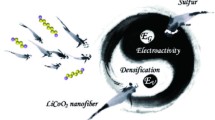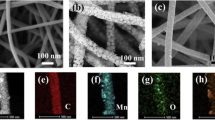Abstract
Low volumetric energy density is a bottleneck for the application of lithium-sulfur (Li-S) battery. The low-density sulfur cooperated with the light-weight carbon substrate realizes electrochemical cycle stability, but leads to worse volumetric energy density. Here, nickel ferrite (NiFe2O4)nanofibers as novel substrate for sulfur not only anchor lithium polysulfides to enhance the cycle stability of sulfur cathode, but also contribute to the high volumetric capacity of the S/nickel ferrite composite. Specifically, the S/nickel ferrite composite presents an initial volumetric capacity of 1,281.7 mA h cm−3-composite at 0.1 C rate, 1.9 times higher than that of S/carbon nanotubes, due to the high tap density of the S/nickel ferrite composite.
摘要
锂-硫电池因其较高的理论质量能量密度而广为人知. 然而, 与以重质过渡金属氧化物作为正极材料的传统锂离子电池相比, 锂-硫较低的体积能量密度是其实际应用的瓶颈. 此外, 硫单质通常与轻质导电碳基底材料复合, 以实现其电化学循环稳定性. 这使得锂-硫电池实际体积能量密度更低. 本文通过静电纺丝方法制备了铁酸镍纳米纤维, 并将其用作新型载体材料. 铁酸镍不仅可以化学固定多硫化锂, 提高硫电极的循环稳定性, 而且有利于硫/铁酸镍的高体积比容量. 测试结果显示, 相比于硫/碳纳米管复合材料, 硫/铁酸镍复合材料具有更高的振实密度; 在0.1 C倍率充放电时, 以复合材料为活性物质计算, 该复合材料的初始体积比容量为1281.7 mA h cm−3, 是硫/碳纳米管复合材料容量的1.9倍. 本工作提出以高振实密度的金属铁氧体材料来实现硫正极的高稳定性和高体积比容量, 这一新策略有助于实现锂-硫电池的高体积能量密度.
Similar content being viewed by others
References
Bruce PG, Freunberger SA, Hardwick LJ, et al. Li–O2 and Li–S batteries with high energy storage. Nat Mater, 2012, 11: 19–29
Gao XP, Yang HX. Multi-electron reaction materials for high energy density batteries. Energy Environ Sci, 2010, 3: 174–189
Gao J, Abruña HD. Key parameters governing the energy density of rechargeable Li/S batteries. J Phys Chem Lett, 2014, 5: 882–885
Pang Q, Liang X, Kwok CY, et al. Advances in lithium–sulfur batteries based on multifunctional cathodes and electrolytes. Nat Energy, 2016, 1: 16132
Manthiram A, Fu Y, Chung SH, et al. Rechargeable lithium–sulfur batteries. Chem Rev, 2014, 114: 11751–11787
Fang X, Peng H. A revolution in electrodes: recent progress in rechargeable lithium-sulfur batteries. Small, 2015, 11: 1488–1511
Lai C, Gao XP, Zhang B, et al. Synthesis and electrochemical performance of sulfur/highly porous carbon composites. J Phys Chem C, 2009, 113: 4712–4716
Xu T, Song J, Gordin ML, et al. Mesoporous carbon–carbon nanotube–sulfur composite microspheres for high-areal-capacity lithium–sulfur battery cathodes. ACS Appl Mater Interfaces, 2013, 5: 11355–11362
Cheng XB, Huang JQ, Zhang Q, et al. Aligned carbon nanotube/sulfur composite cathodes with high sulfur content for lithium–sulfur batteries. Nano Energy, 2014, 4: 65–72
Zhang Z, Jing HK, Liu S, et al. Encapsulating sulfur into a hybrid porous carbon/CNT substrate as a cathode for lithium–sulfur batteries. J Mater Chem A, 2015, 3: 6827–6834
Babu G, Reddy Arava LM. Graphene-decorated graphite–sulfur composite as a high-tap-density electrode for Li–S batteries. RSC Adv, 2015, 5: 47621–47627
Zhang Y, Li K, Huang J, et al. Preparation of monodispersed sulfur nanoparticles-partly reduced graphene oxide-polydopamine composite for superior performance lithium-sulfur battery. Carbon, 2017, 114: 8–14
Zhang Y, Li K, Li H, et al. High sulfur loading lithium–sulfur batteries based on a upper current collector electrode with lithiumion conductive polymers. J Mater Chem A, 2017, 5: 97–101
Ji X, Lee KT, Nazar LF. A highly ordered nanostructured carbon–sulphur cathode for lithium–sulphur batteries. Nat Mater, 2009, 8: 500–506
Zhang B, Qin X, Li GR, et al. Enhancement of long stability of sulfur cathode by encapsulating sulfur into micropores of carbon spheres. Energy Environ Sci, 2010, 3: 1531–1537
Li GC, Hu JJ, Li GR, et al. Sulfur/activated-conductive carbon black composites as cathode materials for lithium/sulfur battery. J Power Sources, 2013, 240: 598–605
Li Z, Yuan L, Yi Z, et al. Insight into the electrode mechanism in lithium-sulfur batteries with ordered microporous carbon confined sulfur as the cathode. Adv Energy Mater, 2014, 4: 1301473
Li GC, Li GR, Ye SH, et al. A polyaniline-coated sulfur/carbon composite with an enhanced high-rate capability as a cathode material for lithium/sulfur batteries. Adv Energy Mater, 2012, 2: 1238–1245
Xie J, Yang J, Zhou X, et al. Preparation of three-dimensional hybrid nanostructure-encapsulated sulfur cathode for high-rate lithium sulfur batteries. J Power Sources, 2014, 253: 55–63
Li G, Sun J, Hou W, et al. Three-dimensional porous carbon composites containing high sulfur nanoparticle content for highperformance lithium–sulfur batteries. Nat Commun, 2016, 7: 10601
Zhang Z, Kong LL, Liu S, et al. A high-efficiency sulfur/carbon composite based on 3D graphene nanosheet@carbon nanotube matrix as cathode for lithium-sulfur battery. Adv Energy Mater, 2017, 7: 1602543
Yang CP, Yin YX, Ye H, et al. Insight into the effect of boron doping on sulfur/carbon cathode in lithium–sulfur batteries. ACS Appl Mater Interfaces, 2014, 6: 8789–8795
Qiu Y, Li W, Zhao W, et al. High-rate, ultralong cycle-life lithium/sulfur batteries enabled by nitrogen-doped graphene. Nano Lett, 2014, 14: 4821–4827
Zhou W, Wang C, Zhang Q, et al. Tailoring pore size of nitrogen-doped hollow carbon nanospheres for confining sulfur in lithiumsulfur batteries. Adv Energy Mater, 2015, 5: 1401752
Zhou G, Paek E, Hwang GS, et al. Long-life Li/polysulphide batteries with high sulphur loading enabled by lightweight threedimensional nitrogen/sulphur-codoped graphene sponge. Nat Commun, 2015, 6: 7760–7770
Wang L, Dong Z, Wang D, et al. Covalent bond glued sulfur nanosheet-based cathode integration for long-cycle-life Li–S batteries. Nano Lett, 2013, 13: 6244–6250
Zu C, Manthiram A. Hydroxylated graphene-sulfur nanocomposites for high-rate lithium-sulfur batteries. Adv Energy Mater, 2013, 3: 1008–1012
Wang Z, Dong Y, Li H, et al. Enhancing lithium–sulphur battery performance by strongly binding the discharge products on aminofunctionalized reduced graphene oxide. Nat Commun, 2014, 5: 5002–5009
Wei Seh Z, Li W, Cha JJ, et al. Sulphur–TiO2 yolk–shell nanoarchitecture with internal void space for long-cycle lithium–sulphur batteries. Nat Commun, 2013, 4: 1331–1336
Pang Q, Kundu D, Cuisinier M, et al. Surface-enhanced redox chemistry of polysulphides on a metallic and polar host for lithium-sulphur batteries. Nat Commun, 2014, 5: 4759–4766
Liang X, Kwok CY, Lodi-Marzano F, et al. Tuning transition metal oxide-sulfur interactions for long life lithium sulfur batteries: the “goldilocks” principle. Adv Energy Mater, 2016, 6: 1501636
Tao X, Wang J, Liu C, et al. Balancing surface adsorption and diffusion of lithium-polysulfides on nonconductive oxides for lithium–sulfur battery design. Nat Commun, 2016, 7: 11203–11211
Fan Q, Liu W, Weng Z, et al. Ternary hybrid material for highperformance lithium–sulfur battery. J Am Chem Soc, 2015, 137: 12946–12953
Yuan Z, Peng HJ, Hou TZ, et al. Powering lithium–sulfur battery performance by propelling polysulfide redox at sulfiphilic hosts. Nano Lett, 2016, 16: 519–527
Li X, Liang J, Lu Y, et al. Bi2S3 in-situ formed in molten S environment stabilized sulfur cathodes for high-performance lithium-sulfur batteries. J Power Sources, 2016, 329: 379–386
Lei T, Chen W, Huang J, et al. Multi-functional layered WS2 nanosheets for enhancing the performance of lithium-sulfur batteries. Adv Energy Mater, 2017, 7: 1601843
Babu G, Masurkar N, Al Salem H, et al. Transition metal dichalcogenide atomic layers for lithium polysulfides electrocatalysis. J Am Chem Soc, 2017, 139: 171–178
Cui Z, Zu C, Zhou W, et al. Mesoporous titanium nitride-enabled highly stable lithium-sulfur batteries. Adv Mater, 2016, 28: 6926–6931
Deng DR, An TH, Li YJ, et al. Hollow porous titanium nitride tubes as a cathode electrode for extremely stable Li–S batteries. J Mater Chem A, 2016, 4: 16184–16190
Hao Z, Yuan L, Chen C, et al. TiN as a simple and efficient polysulfide immobilizer for lithium–sulfur batteries. J Mater Chem A, 2016, 4: 17711–17717
Sun Z, Zhang J, Yin L, et al. Conductive porous vanadium nitride/graphene composite as chemical anchor of polysulfides for lithium-sulfur batteries. Nat Commun, 2017, 8: 14627
Zhao X, Liu M, Chen Y, et al. Fabrication of layered Ti3C2 with an accordion-like structure as a potential cathode material for high performance lithium–sulfur batteries. J Mater Chem A, 2015, 3: 7870–7876
Bao W, Su D, Zhang W, et al. 3D metal carbide@mesoporous carbon hybrid architecture as a new polysulfide reservoir for lithium-sulfur batteries. Adv Funct Mater, 2016, 26: 8746–8756
Liang X, Rangom Y, Kwok CY, et al. Interwoven MXene nanosheet/carbon-nanotube composites as Li-S cathode hosts. Adv Mater, 2017, 29: 1603040
Peng HJ, Zhang G, Chen X, et al. Enhanced electrochemical kinetics on conductive polar mediators for lithium-sulfur batteries. Angew Chem, 2016, 128: 13184–13189
Liang X, Hart C, Pang Q, et al. A highly efficient polysulfide mediator for lithium–sulfur batteries. Nat Commun, 2015, 6: 5682–5689
Blöchl PE. Projector augmented-wave method. Phys Rev B, 1994, 50: 17953–17979
Kresse G, Joubert D. From ultrasoft pseudopotentials to the projector augmented-wave method. Phys Rev B, 1999, 59: 1758–1775
Perdew JP, Chevary JA, Vosko SH, et al. Atoms, molecules, solids, and surfaces: Applications of the generalized gradient approximation for exchange and correlation. Phys Rev B, 1992, 46: 6671–6687
Chinnasamy CN, Narayanasamy A, Ponpandian N, et al. Mixed spinel structure in nanocrystalline NiFe2O4. Phys Rev B, 2001, 63: 184108–184113
Carta D, Casula MF, Falqui A, et al. A structural and magnetic investigation of the inversion degree in ferrite nanocrystals MFe2O4 (M=Mn, Co, Ni). J Phys Chem C, 2009, 113: 8606–8615
Rios E, Gautier JL, Poillerat G, et al. Mixed valency spinel oxides of transition metals and electrocatalysis: case of the MnxCo3-xO4 system. Electrochim Acta, 1998, 44: 1491–1497
Ponpandian N, Balaya P, Narayanasamy A. Electrical conductivity and dielectric behaviour of nanocrystalline NiFe2O4 spinel. J Phys-Condens Matter, 2002, 14: 3221–3237
Zhao X, Fu Y, Wang J, et al. Ni-doped CoFe2O4 hollow nanospheres as efficient bi-functional catalysts. Electrochim Acta, 2016, 201: 172–178
Zhang YZ, Zhang Z, Liu S, et al. Free-standing porous carbon nanofiber/carbon nanotube film as sulfur immobilizer with high areal capacity for lithium–sulfur battery. ACS Appl Mater Interfaces, 2018, 10: 8749–8757
Cao Y, Li X, Zheng M, et al. Ultra-high rates and reversible capacity of Li-S battery with a nitrogen-doping conductive lewis base matrix. Electrochim Acta, 2016, 192: 467–474
Acknowledgements
This work is financially supported by the New Energy Project for Electric Vehicles in National Key Research and Development Program (2016YFB0100200) and the National Natural Science Foundation of China (21573114 and 51502145)
Author information
Authors and Affiliations
Corresponding author
Additional information
Ze Zhang is a Lecturer in the School of Chemistry, Nanchang University. He received his BS degree in 2012 from the College of Chemistry, and PhD degree in 2017 from the School of Materials Science and Engineering, Nankai University of China. His general research interest is in the area of advanced functional materials for rechargeable batteries with a focus on the exploration of high-energy Li-S battery.
Xue-Ping Gao is a Professor in the Institute of New Energy Material Chemistry, Nankai University, China. He received his doctorate at the Department of Chemistry from Nankai University in 1995. He used to work as a visiting research fellow at Kogakuin University in Japan from 1997 to 1999. Currently, his main research focuses on energy storage materials for power sources, including Li-ion batteries, Li-S battery and solar rechargeable battery.
Electronic supplementary material
Rights and permissions
About this article
Cite this article
Zhang, Z., Wu, DH., Zhou, Z. et al. Sulfur/nickel ferrite composite as cathode with high-volumetric-capacity for lithium-sulfur battery. Sci. China Mater. 62, 74–86 (2019). https://doi.org/10.1007/s40843-018-9292-7
Received:
Accepted:
Published:
Issue Date:
DOI: https://doi.org/10.1007/s40843-018-9292-7




